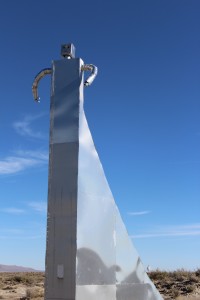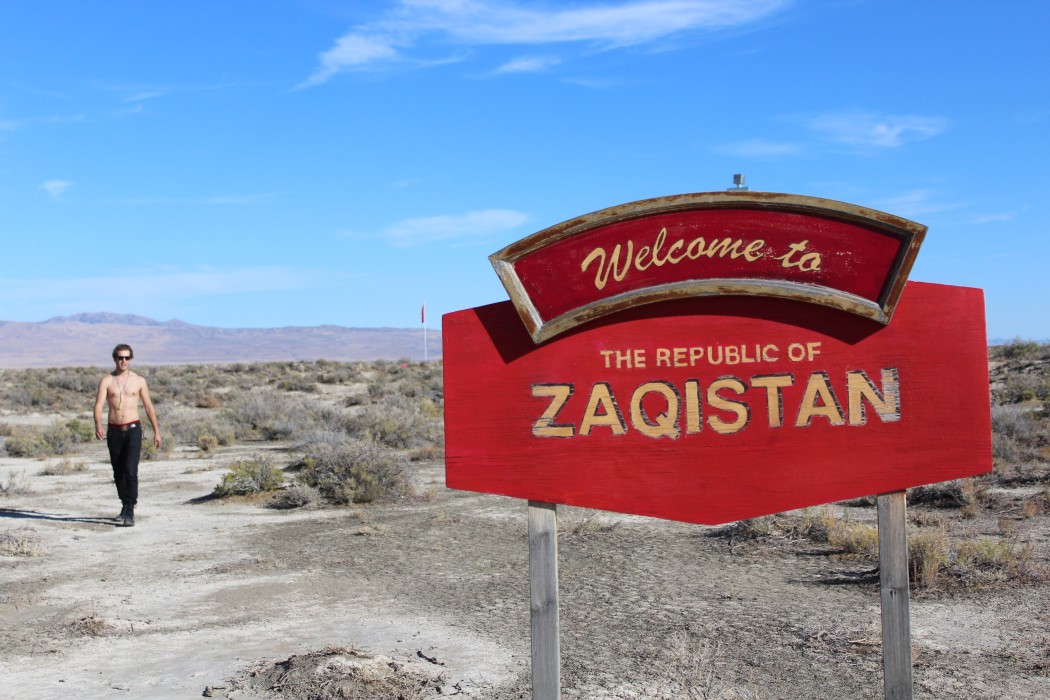Did you know there’s a micro-nation in Utah? Believe it, it’s called Zaqistan.
In a not-so-far-off land, surrounded by mountains, sagebrush and local wildlife, lies the isolated Republic of Zaqistan.
Largely unknown and rarely visited, this uninhabited independent nation is located in the northwestern desert of Utah, four hours away from Salt Lake City and miles from any source of water or human civilization.
Zaqistan was formed 11 years ago when Zaq Landsberg bought two acres of land from eBay and created a conceptual art piece designed to challenge views of what makes a government and a border. He did this by declaring Zaqistan an independent republic, complete with a border port of entry and a tourism office exhibited at Central Utah Art Center (CUAC) in Salt Lake City.
As part of the art exhibit, CUAC shows tourism videos, shares Zaqistani history and sells fake Zaqistani passports and citizenship documents along with a variety of Zaqistani souvenirs. Last Sunday featured a first-ever tour that brought visitors to the micro-nation.
“What drew me in was this fabled land of Zaqistan nestled in the hinterlands of Box Elder County,” said Forrest Schoessow, a master’s student in geography. “This journey out there had all the trappings of high adventure, as far as I’m concerned. Like arduous trek out there, shrouded in mystery.”
Schoessow and several other students from Utah State University traveled three hours from Cache Valley last Sunday afternoon for a rare opportunity to tour the Republic of Zaqistan.
“It’s literally in the middle of nowhere,” said Mikey Kettinger, a graduate student studying the intersection of art and science, technology, engineering and math (ArtSTEM). “It’s surrounded by millions of sagebrushes, and rattlesnakes, and beetles, and fire ants and sand. No humans anywhere close, at all.”
After a long and bumpy car ride on paths that were not often traveled, the USU students were greeted by a giant metal robot sculpture and the bright red Zaqistani flag.
Shortly after their arrival, they were joined by a second group who had driven up from Salt Lake, led by the founder of the small micro-nation, Zaq Landsberg, who was hosting this expedition for the first time.

The largest monument in Zaqistan. Photo by Mikey Kettinger
Organized as a tourist experience, Landsberg introduced his 20 guests to the history of Zaqistan along with the various art sculptures located within the nation, including the Decennial Monument, the Victory Arch, a plastic wildflower garden, the Guardians of Zaqistan and more.
“The point of Zaqistan is to make us question what constitutes a nation, what counts as a country,” Landsberg said. “What is the difference between the United States and Taiwan, which is not a [United Nations] member state, and the Vatican which is, and how these lines, these property lines in my case or borders between countries and these abstract concepts have very serious real world consequences.”
While Zaqistan is not a country that is recognized by other states, the manufacture of official government-looking forms and passports is meant to raise questions about the difference between the United States and Zaqistan that will raise red flags about legitimacy, he said.
The tourism exhibit was a way to bring others to the desert to see the micro-nation as well as simulate a developing nation with little-to-no natural resources in need of a source of income. Landsberg also wanted to get people thinking about the political issues his art was trying to express.
“I think art is incredibly powerful and can do a lot to start conversations like the ones that we’re having right now,” said Beth Shirley, a Ph.D. student in technical communications and rhetoric. “That wasn’t the sense that I got yesterday. I think it’s very easy for things like this for the art side of it to get lost in the conceptual side of it, for it to be too abstract for people to really get what’s going on.”
Kettinger said he noticed a disconnection between the people there who were interested in the tourism aspect and the conceptual artwork, and the people like the other USU students who were interested in creating a dialogue about the social issues the art was presenting.
One such social issue came to Landsberg unexpectedly as a result of his effort to create an authentic independent country.
“I have received like hundreds of emails from Pakistanis who want to immigrate to Zaqistan and move their small businesses there, and move their families there,” he said.
Schoessow found this idea dark and disturbing to hear during the fun and lighthearted event.
“These are people that are willing to abandon their culture and their traditions and their home and family and everything that they’ve ever known,” he said. “They’re willing to take a gamble on going anywhere, because anywhere could possibly be better than going home, and I think that’s super heavy and worth considering thinking about.”
These responses created a paradox within the project and its goals, Landsberg said, because Zaqistan implores people not to take things at face value, to question and scratch the surface at what is there. Then there are people who see it and believe it is real which requires him to explain this is a conceptual art piece, not a real country that can sustain human beings.
Landsberg also described a situation regarding a few friends who were born and raised in India and were given Zaqistani citizenship early in the nation’s history. They now hold refugee status, which makes Zaqistan the only place they hold citizenship to.
“I think that reveals how dark and sad that is,” Landsberg said, “that Zaqistan is like this weirdo project out in the middle of the desert is the only entity that will recognize these people as citizens anywhere.”
Schoessow saw this situation as a potential catalyst for real discussion about foreign policies and immigration. He would like to see the refugees given a voice through this project to make a political statement.
In the future, Landsberg said he hopes to get more people like the USU students involved with Zaqistan and talking about these issues. One day he’d like to see Zaqistan change from a quirky weird art piece in the middle of the desert to a deep political statement.
“It all seemed to come back to people and place and sort of the connection that folks could establish with nature and their natural surroundings that folks seemed to appreciate,” Schoessow said, “and when you throw down an arbitrary like political boundary and declare an independent republic in the middle of the dessert, that just makes it that much better.”
– miranda.lorenc@gmail.com
@miranda_lorenc

